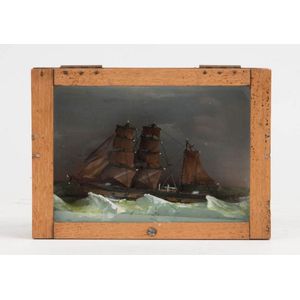Oak-cased Ship Diorama, Early 20th Century
Ship diorama in oak case, early 20th century. Height 16 cm, width 22 cm, depth 8.5 cm
You must be a subscriber, and be logged in to view price and dealer details.
Subscribe Now to view actual auction price for this item
When you subscribe, you have the option of setting the currency in which to display prices to $Au, $US, $NZ or Stg.
This item has been sold, and the description, image and price are for reference purposes only.
- Diorama - When used in relation to antiques and collectables, a diorama is a three dimensional display, usually within a domed or rectangular glass case.
As the feathers of birds are more easily damaged than the skin of an animal, most taxidermied birds are displayed within a glazed diorama. The birds will be set in lifelike poses in a naturalistic landscape, usually standing a branch within the diorama. Animals will be displayed set in the landscape they inhabit. The foreground will be set with gravel, rocks and bushes, while the background will be painted.
While most natural history dioramas can be easily picked up and carried by one person, some larger examples were made that were suitable for display at exhibitions.
The other type of diorama commonly seen is a model ship enclosed in a rectangular glass box, the ship depicted floating on the sea. - Oak - Native to Europe and England, oak has been used for joinery, furniture and building since the beginning of the medieval civilisation. It is a pale yellow in colour when freshly cut and darkens with age to a mid brown colour.
Oak as a furniture timber was superceded by walnut in the 17th century, and in the 18th century by mahogany,
Semi-fossilised bog oak is black in colour, and is found in peat bogs where the trees have fallen and been preserved from decay by the bog. It is used for jewellery and small carved trinkets.
Pollard oak is taken from an oak that has been regularly pollarded, that is the upper branches have been removed at the top of the trunk, result that new branches would appear, and over time the top would become ball-like. . When harvested and sawn, the timber displays a continuous surface of knotty circles. The timber was scarce and expensive and was used in more expensive pieces of furniture in the Regency and Victorian periods.
This item has been included into following indexes:
Visually similar items

A maritime scene print in huon pine frame, circa 1860, Frame 61 x 74 cm
Sold by
in
for
You can display prices in $Au, $US, $NZ or Stg.

A vintage SS Niagara photograph, oak framed by H Winkelmann. Height 61 cm. Length 100 cm
Sold by
in
for
You can display prices in $Au, $US, $NZ or Stg.

French school, gilt framed oil on canvas, 'A Village of Fishermen' initialled R.T., approx 64 cm x 42 cm
Sold by
in
for
You can display prices in $Au, $US, $NZ or Stg.

19th century Colonial ship woolwork embroidery
Sold by
in
for
You can display prices in $Au, $US, $NZ or Stg.
